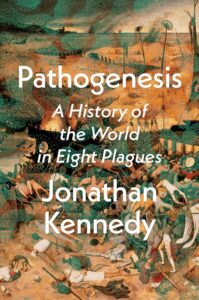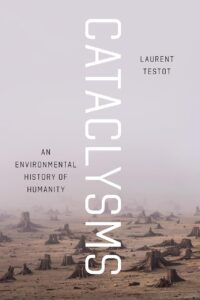Pathogenesis and Cataclysms – Jonathan Kennedy and Laurent Testot
 Pathogenesis: A History of the World in Eight Plagues. By Jonathan Kennedy. (Crown: New York, 2023. Cloth, $30.00.)
Pathogenesis: A History of the World in Eight Plagues. By Jonathan Kennedy. (Crown: New York, 2023. Cloth, $30.00.)
Both of these books, chronicling the challenges faced by Homo sapiens in the form of environmental factors, some created by man and others the product of concurrent evolution, start during the Paleolithic era and pay special attention to how Homo sapiens fueled or adapted to these threats over time.  Both provide a picture of “cataclysms” coevolving with man over time, whether it be through the lifecycle of disease or the demonstratable and drastic changes our pursuit of a middle class lifestyle dependent on the use of energy sources that are driving a disastrous form of climate change.
Both provide a picture of “cataclysms” coevolving with man over time, whether it be through the lifecycle of disease or the demonstratable and drastic changes our pursuit of a middle class lifestyle dependent on the use of energy sources that are driving a disastrous form of climate change.
As in the book Mosquito: A History of our Deadliest Predator, the burden of proof lies on the authors. Were changes in the earth and the Homo sapiens species correlative, causative, or both? Whereas Testot’s goal is to track how human beings were affected by the environment, and perhaps more importantly, how they affected it, Kennedy is attempting to chart how disease was determinative in the course of human evolution, traced over a time period from the paleolithic to the present day. He jumps into the fray of authors attempting to the determine why Homo sapiens, out of all the genus of Homos, came to be the only member of the genus left, even though several other Homos co-existed with Homo sapiens, even interbreeding with them, as was the case with Neanderthals. Kennedy’s answer to this perpetual puzzle is that disease wiped out Homo sapiens competitors. As to why Homo sapiens did not immediately move north and why Neanderthals did not move south, Kennedy explains:
…infectious diseases created an invisible barrier: it was impossible for Homo sapiens to migrate out of Africa because sooner or later they would encounter Neanderthals and their pathogens and get ill, and the same was true when Neanderthals pushed southward. (30)
The solution to the problem that eventually allowed Homo sapiens to colonize Europe? Interbreeding with Neanderthals, who passed genetic disease immunity to the resulting children, who, according to Kennedy, then spread the immunity quickly among other Homo sapiens. Unfortunately, this did not seem to be a reciprocal transaction, and other Homos like Neanderthals died out as a result of diseases Homo sapiens had developed immunity to. Kennedy claims we can see this advantage in DNA samples taken from the different groups.
Kennedy is at his strongest when he is discussing disease from the Black Plague on. Here we have increasingly definitive research demonstrating how disease effected societies. I’d like to say this a worldwide history, but like other work I’ve read that attempt to trace patterns through long duree of history, this work is almost exclusively Eurocentric, including the inevitable examination of the decimation of the Americas by European diseases. I am waiting for a history of the Black Death in China or the rest of Asia. Did it happen in Africa? If the sources don’t exist, why not say so?
Testot takes a similar immense scope of Homo history, but he believes environment and Homo sapiens‘ ability to manipulate it to be the determining factor in human evolution:
What makes us unique in the living world is momentum; the ability to bring about continual change is specific to humans. Human culture is constantly evolving under the combined pressure of societal choices and environmental transformations. And this culture has, in turn, long modified its environment, creating continual feedback between culture and nature, of which our bodies are the product. Humans escaped natural determinism that day we were able to use culture to make a lasting impact on our surroundings…We just have to work out when this might have taken place. (9)
Testot’s examination is interesting because of his long duree focus on the interaction between humans and their environment. As mentioned above, he examines the turning points when humans effected or responded to their environments in a way that brought about sustained change. His argument that the environment affected human evolution was a bit Lamarckian for me – he does not produce the same DNA evidence that Kennedy leverages in Pathogenesis. I understand that certain traits were selected for, but does Testot’s thesis depend upon intentionality or simply the survival of genes better adapted to meet environmental challenges? How much is genetics and how much is culture?
Ultimately, Testot baldly asserts that humans have taken our control over the environment to a dangerous extreme that is leading the environment to change in ways that may destroy all human life, maybe even all life. Evolution can not adapt fast enough to save the planet, and humans are not acting quickly enough on a human timescale to curb the changes we have made to the environment in order to bring environmental conditions to a place where we reach a sustenance level. Humans have also created a completely lopsided demographic that has driven these negative changes.
I read these books in sequence, unaware that they would be tackling similar themes and timescales in different ways. I think both authors have important points to make, but their books reveal and strengths and weaknesses of taking on human history from start to finish. Testot should be applauded for his focus on how cataclysms effected the globe (excepting Africa for the most part) – this is a first book I have read in this genre that does so. Kennedy deftly shows how Europeans adapted to various plagues they encountered in history. The question both books leave open is: as we now have the ability and power to alter the environment, how do we do so in a way that is healthy and sustainable for a global population? Testot clumsily interjects:
Species become invasive when they prosper in area where they have no natural predators. And humans have no predators at all, particularly now that we have overcome epidemics. (49)
Oops. Maybe we can forgive this, as the originally French version of this book was published in 2017. But the brief note on the English edition in 2020, Testot makes no mention of COVID-19. AIDS rates one page. For Testot, plagues are an artifact of the past, whereas for Kennedy they are not only a present danger, but also lurking in the future. They seem to reach the same conclusion though: mankind has got to do something about it, not just to a create a healthy and hospitable world, but to create equity. Both these works chronicle the struggle between nature and man, what perhaps makes us different from all other animals. It’s up to us to determine how this future will turn out.
